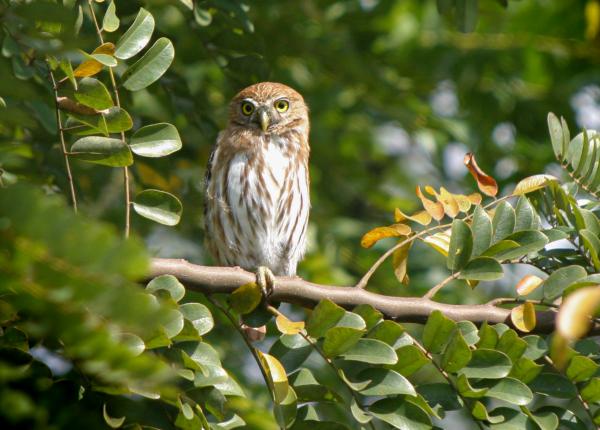Did You Know?
- The word "ferruginous" means rust-colored
- Ferruginous Pygmy-owl nestlings first open their eyes when they are around 4 days old.
How The Peregrine Fund is Helping
The Peregrine Fund is not working directly with Ferruginous Pygmy-owls, but our conservation efforts through habitat protection, education, and community outreach extend to all raptor species, including this owl. We also supply literature to researchers from our avian research library, which helps scientists around the world gather and share important information on raptor conservation. We also support the Global Raptor Impact Network (GRIN), which gives raptor researchers tools to more efficiently conduct their own studies while contributing to a global program. GRIN also provides citizen scientists a way to participate in raptor science and conservation. support
Where They Live
The Ferruginous Pygmy-owl is found throughout much of South and Central America, Mexico, and in the southern part of the United States, mainly in Arizona and Texas. This small owl makes its home in a number of different habitats including tropical lowlands, primary and secondary forests, woodlands, riparian habitats, gallery forest, plantations, and sometimes even urban areas.
Why They Need our Help
Although the Ferruginous Pygmy-owl is categorized as Least Concern on a global level, it is categorized as Endangered in parts of its North American range. Some of the threats this species faces include loss of habitat. Sadly, these owls in some parts of their range, are also captured and kept in cages as pets, which is not only harmful to the individuals being held in captivity, but it also reduces the number of birds in the wild to reproduce.
What They Eat
The Ferruginous Pygmy-owl actively hunts during the day, as well as during the crepuscular hours - the hour just before sunrise and just after sunset. This small owl feeds on several different small animals. It will take insects, reptiles, small mammals and even other birds. Though not as common, it will also predate upon amphibians. It is known to kill its prey by biting down on their necks, severing their spinal cords.
Nests, Eggs, and Young
These small owls don't build their own nests. They lay their eggs in cavities in trees, tree stumps, and termite mounds. Oftentimes, they nest in holes excavated by woodpeckers. They aren't known to bring any nest materials to lay as a base before laying eggs, in fact, some owls were observed removing nesting material from nest boxes before laying their eggs on the bare wood.
When the time is right, females will lay 3-5 eggs. The females will be in charge of all of the incubation duties until the owlets hatch, at about 23-28 days. During this time, the male is responsible for finding enough food for himself, the female, and the owlets until they are about 3 weeks old. The female will take the prey from the male and tear it up into tiny pieces, which she feeds to the nestlings. When they are a bit older, they will be able to tear their own food. By the time the nestlings are between 3 and 4 weeks old, they will fledge for the first time. They will spend the next 7-8 weeks learning how to hunt and avoid dangers before dispersing from their parents' territory.
Ferruginous Pygmy-owl and the World Center for Birds of Prey
Come to The Peregrine Fund's World Center for Birds of Prey and meet Rusty, our Eastern Screech-owl, and Winston, our Western Screech-owl. They are often out greeting visitors during bird presentations and sit comfortably on their handlers' gloves, which allows you to get a close up view of these exceptionally cute raptors.
Additionally, the World Center for Birds of Prey offers fun ways to learn about birds of prey. Interactive activities, tours, interesting videos and a children's room feature activities from coloring sheets to quizzes to costumes. There is also a touch table with owl feathers and other natural objects for exploration.
References:
https://www.owlpages.com/owls/species.php?s=2070
Proudfoot, G. A., R. R. Johnson, and R. Larsen (2020). Ferruginous Pygmy-Owl (Glaucidium brasilianum), version 1.0. In Birds of the World (S. M. Billerman, Editor). Cornell Lab of Ornithology, Ithaca, NY, USA. https://doi.org/10.2173/bow.fepowl.01










